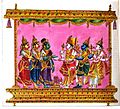Maheshwara murtams

Maheshwara murtas are forms of Shiva revered in the Shivagamas of southern Shaiva Siddhanta sect of Saivism. It is usually counted to twenty five.[1] Sritattvanidhi calls these as Panchavimsatilīlāmūrti (twenty five sportive forms).[2] These forms are based on Puranas and Ithihasa (history) in which Shiva's divine play is explained with different stories. Most of these forms are present in South Indian temples as main deities of sanctum or sculptures and reliefs in the outer walls of Shiva temples.
Description[]
Hindu iconography on Shiva is well developed in middle age all over India with his various divine plays described in Purana- ithihasas. Shivagamas tells devotees to worship these forms for distinct purposes. There are so many numbers of these forms available. Most prevalent is twenty five maheshwara murtams or Panchavimsati murtams mentioned in Shivagamas and sixty four shiva murtams (Ashdashta Murtas).
25 Maheshwara murtas[]
The common list believed as twenty five Maeshwara murtas is given below.[1][3]
| Murta | Depiction | Description[4][5] |
|---|---|---|
| Bhikshatana |
 |
The form in which he mocked the arrogance of Rishis from Darukavana. He is depicted as a naked mendicant followed by the Mohini avatar of Vishnu. |
| Kamari (The Shiva which burnt Kamadeva, god of lust) |
 |
Devas planned to make Shiva fall in love with Parvati, for the birth of Shiva's son. They sent the god of lust for this task, but he was incinterated by the third eye of Shiva. Later, as his wife Rati requested, he was resurrected with the condition that he will be only visible to her. |
| Kalantaka (Shiva who killed Kaladeva Yama, god of death.) |
 |
Markandeya was an ardent devotee of Shiva who was given only 16 years to live. When the day he was destined to die arrived, Yama came to take the soul of Markandeya while he was in continuous Shiva worship. Yama was killed while he tried to abduct the soul of Markandeya. But later Shiva returned life to Yama because of a request from the gods. Thirukkadavur temple is associated with this Veerasthana and is one of eight heroic playgrounds. |
| Kalyanasundara |
 |
The depiction of the wedding of Shiva with Shakti, in any forms of Sati, Parvati or Meenakshi. |
| Vrishabharuda (Rider of Vrishabha, the holy bull) |
 |
This is the usual form Shiva appears in when in front of his devotees, accompanied with Parvati on white bull, Vrishaba. |
| Chandrasekhara (Wearer of Chandra) |
 |
Daksha, Shiva's father-in-law, cursed Chandra who married Daksha's twenty seven daughters and neglecting most of them, besides Rohini. Chandra sought the attention of Shiva, in which Shiva gave abhaya to him and wore the waning moon on his matted hair because of a curse. |
| Umamaheshwara (Maheshwara with goddess Uma) |
 |
The appearance of divine couple Shiva and Parvati after their marriage. |
| Nataraja (King of the dancers) |
 |
Shiva is depicted dancing for the unstopped motion of the Universe. |
| Tripurantaka (Burner of three forts) |
 |
Shiva burnt the three forts of three evil demons. It is said that he did this just by smiling at them. |
| Jalandharari (Killer of demon Jalandhara) |
Shiva killed Jalandhara, an invincible demon who was the consort of Vrinda, an ardent devotee of Vishnu. He later praised as Tulsi. | |
| Gajasurasamhara |
 |
The killer of Gajasura, a demon took the form of elephant. |
| Virabhadra |
 |
The destroyer of Daksha yajna. |
| Harihara |
 |
A combined form of half Shiva and half Vishnu. |
| Ardhanarishwara |
 |
A combined form of half Shiva and half Parvati. |
| Kirata |
 |
The hunter who bestowed on Arjuna the Pashupatastra. |
| Kankala |
 |
Divine player with the bones of devas after Pralaya. |
| Chandeshanugraha |
 |
Bestower on Chandeshvara Nayanar. |
| Chakraprada |
 |
Giver of the Sudarshana chakra to Vishnu. |
| Somaskanda |
 |
A householder with Uma and Skanda. |
| Ekapada |
 |
Shiva who only has one foot. This form is the merging point of Brahma and Vishnu during mahapralaya. |
| Vigneshanugraha |
Shiva with Parvati and Vignesha. | |
| Dakshinamurthy |
 |
The south facing god and first teacher. |
| Nilakantha |
 |
The one with the blue throat. Drinker of halahala poison during the churning of milk sea. |
| Lingodbhava |
 |
Shiva emerging from jyotir linga pillar amidst Brahma and Vishnu |
| Sukhasana |
 |
Shiva sitting in ease. |
See also[]
- Nataraja, form of Shiva
References[]
- ^ a b Durai Raja Singam, S. (1977). Ananda Coomaraswamy, the Bridge Builder: A Study of a Scholar-colossus. Khee Meng Press. p. 8.
- ^ Narasimha Murthy, A. V. (2001). Hemakuta: Recent Researches in Archaeology and Museology : Shri C.T.M. Kotraiah Felicitation Volume 1. Bharatiya Kala Prakashan. p. 177. ISBN 9788186050668.
- ^ Subas Rai, Bhanu Agrawal (1995). Third eye: myth or a scientific reality?. Pandey Publications House. p. 3.
- ^ Gopinatha Rao, T. A. (1993). Elements of Hindu iconography. Motilal Banarsidass Publishers. ISBN 9788120808782.
- ^ Senrayan, B; Palanichamy, S (2014). Siva temples of sembiyan mahadevi in chola region a historical study. Madurai Kamraj University. pp. 198–231.
External links[]
- Forms of Shiva